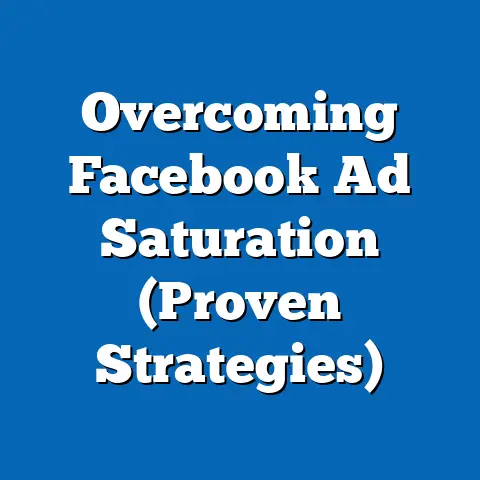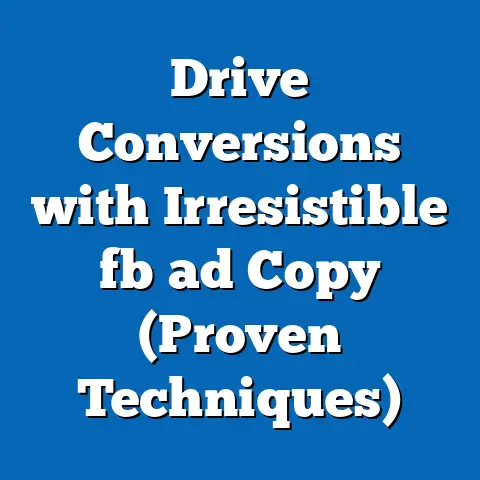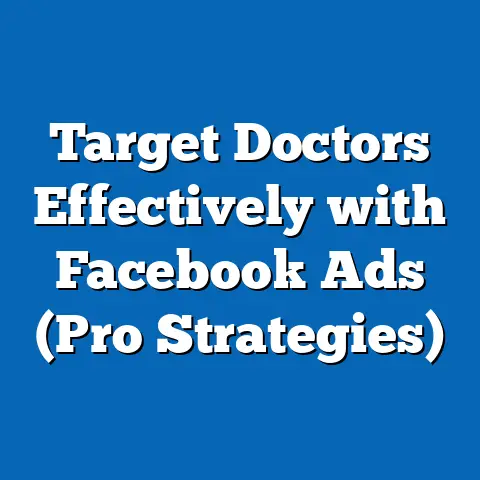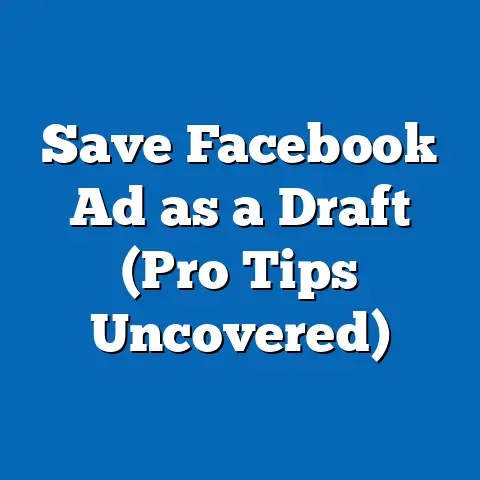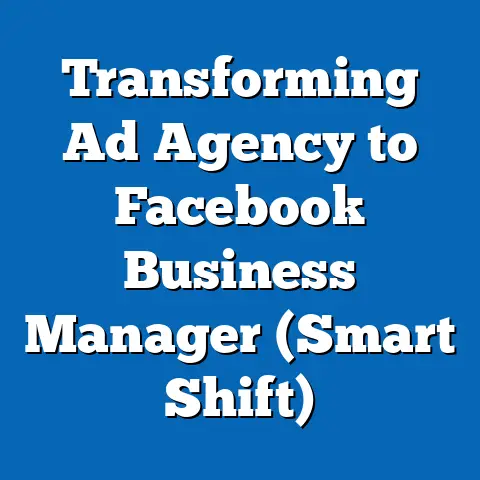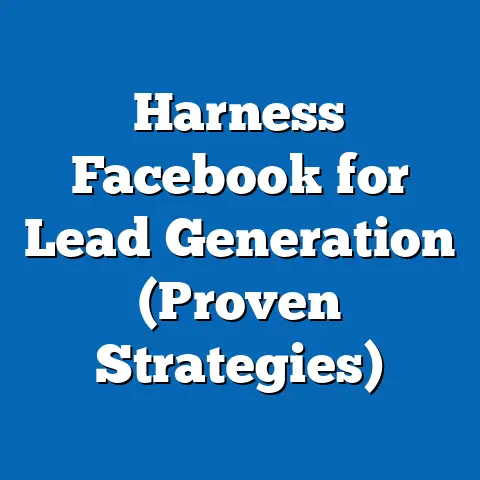Mastering Facebook Ads for Higher ROI (Profit-Boosting Secrets)
I remember when I first started dabbling in Facebook Ads. It felt like throwing money into a black hole. I’d boost a post here, run a quick campaign there, and see… well, not much. It was frustrating, to say the least. I felt like I was missing something, some secret sauce that other businesses were using to generate real results.
Then, I met Maria. Maria owned a small, local coffee shop called “The Daily Grind.” She was struggling to attract customers during the slow mid-afternoon hours. She’d tried everything – loyalty programs, flyers, even a brief stint with a local radio ad. Nothing seemed to stick. One day, feeling particularly defeated, she decided to give Facebook Ads a shot.
Initially, she made the same mistakes I did. She boosted a generic post about her coffee shop, targeting a broad audience in her city. The results? A handful of likes, a few extra website visits, but no noticeable bump in afternoon sales. Discouraged, she almost gave up.
But Maria is a fighter. She decided to dig deeper, to truly understand how Facebook Ads worked. She started researching, reading articles, watching tutorials, and even taking a short online course. She learned about audience segmentation, ad creative optimization, and bidding strategies.
The turning point came when she realized she needed to target a specific audience with a specific message. She created a custom audience of people who had visited her website and another lookalike audience based on her existing customers. Then, she crafted a compelling ad offering a special discount on iced coffee during those slow afternoon hours. The ad featured a vibrant photo of her signature iced latte and a clear call-to-action: “Beat the afternoon slump! Get 20% off iced coffee between 2pm and 4pm!”
The results were immediate. Maria saw a significant increase in foot traffic during those previously slow hours. Her iced coffee sales skyrocketed. More importantly, she started seeing new faces, people who had discovered her coffee shop through her Facebook ad.
Maria’s story isn’t unique. Many small business owners struggle with Facebook Ads initially. But with the right knowledge and strategies, it’s possible to unlock the platform’s potential and achieve a higher return on investment (ROI). In this guide, I’ll share the profit-boosting secrets I’ve learned over the years, drawing from my own experiences and the successes of businesses like Maria’s. This isn’t just a theoretical overview; it’s a practical roadmap to help you master Facebook Ads and achieve your marketing goals.
1. Understanding Facebook Ads
Facebook Ads are a powerful tool for businesses of all sizes. They allow you to reach a vast audience of potential customers with targeted messages, driving traffic, generating leads, and ultimately increasing sales. But before you dive in, it’s crucial to understand the fundamentals of how Facebook Ads work.
At its core, Facebook Ads is an auction-based system. Advertisers bid for the opportunity to show their ads to users based on various targeting parameters. The higher your bid and the more relevant your ad, the more likely it is to be shown to your target audience.
Key elements of Facebook Ads include:
- Targeting Capabilities: Facebook’s powerful targeting options allow you to reach specific demographics, interests, behaviors, and locations. You can target people based on age, gender, location, education, job title, interests, hobbies, and even their purchasing history.
- Ad Formats: Facebook offers a variety of ad formats, including image ads, video ads, carousel ads, collection ads, and lead generation ads. Each format is designed to achieve different objectives and appeal to different audiences.
- Bidding Strategies: You can choose from various bidding strategies, including cost per click (CPC), cost per impression (CPM), and cost per acquisition (CPA). The right bidding strategy depends on your campaign objectives and budget.
The Importance of Defining Clear Marketing Goals
Before you launch any Facebook ad campaign, it’s essential to define clear marketing goals. What do you want to achieve with your ads? Are you trying to increase brand awareness, generate leads, drive traffic to your website, or boost sales?
Common marketing goals for Facebook Ads include:
- Brand Awareness: Increasing the visibility and recognition of your brand among your target audience.
- Lead Generation: Collecting contact information from potential customers for future marketing efforts.
- Website Traffic: Driving traffic to your website to increase engagement and conversions.
- Conversions: Encouraging specific actions, such as purchases, sign-ups, or downloads.
Defining your goals will help you choose the right targeting options, ad formats, and bidding strategies. It will also provide a clear benchmark for measuring the success of your campaign.
Takeaway: Understanding the fundamentals of Facebook Ads and defining clear marketing goals are the first steps towards achieving a higher ROI.
2. Targeting the Right Audience
One of the biggest advantages of Facebook Ads is its ability to target specific audiences. Unlike traditional advertising methods, which often reach a broad and undifferentiated audience, Facebook Ads allows you to reach people who are most likely to be interested in your products or services.
The Importance of Audience Segmentation
Audience segmentation involves dividing your target market into smaller groups based on shared characteristics, such as demographics, interests, behaviors, and purchasing habits. By segmenting your audience, you can create more targeted and relevant ads that resonate with each group.
Using Facebook’s Audience Insights Tool
Facebook’s Audience Insights tool is a valuable resource for identifying the demographics, interests, and behaviors of your potential customers. This tool provides data on the people who are connected to your Facebook page, as well as the broader Facebook audience.
With Audience Insights, you can:
- Identify demographics: Age, gender, location, education, and job title.
- Explore interests: Hobbies, activities, and pages they like.
- Analyze behaviors: Purchasing habits, device usage, and travel patterns.
Creating Custom Audiences and Lookalike Audiences
Facebook allows you to create custom audiences based on your existing customer data. You can upload a list of email addresses, phone numbers, or website visitors to create a custom audience.
Custom audiences are useful for:
- Retargeting: Showing ads to people who have already interacted with your business.
- Upselling: Promoting additional products or services to existing customers.
Lookalike audiences are created by identifying the common characteristics of your existing customers and then finding other Facebook users who share those characteristics.
Lookalike audiences are useful for:
- Expanding your reach: Reaching new potential customers who are similar to your existing customers.
- Improving targeting accuracy: Reaching people who are more likely to be interested in your products or services.
Case Studies and Statistics
Numerous studies have shown the effectiveness of targeted ads versus broad ads. For example, a study by HubSpot found that targeted ads have a 50% higher click-through rate (CTR) than non-targeted ads.
I’ve seen firsthand the impact of targeted advertising. I worked with a local bookstore that was struggling to compete with online retailers. By creating a custom audience of people who had visited their website and a lookalike audience based on their existing customers, we were able to significantly increase their online sales. The key was understanding their customer base and tailoring the ads to their specific interests.
Takeaway: Audience segmentation and targeting are crucial for maximizing the effectiveness of your Facebook Ads. Use Facebook’s Audience Insights tool, create custom audiences and lookalike audiences, and tailor your ads to the specific interests and behaviors of your target audience.
3. Crafting Compelling Ad Creative
Even with the best targeting in the world, your Facebook Ads will fall flat if your ad creative isn’t compelling. Your ad creative is what captures the attention of your target audience and persuades them to take action.
Elements of Effective Ad Creative
Effective ad creative consists of three key elements:
- Visuals: Eye-catching images or videos that grab attention and convey your message.
- Copy: Persuasive text that highlights the benefits of your product or service and encourages action.
- Call-to-Action (CTA): A clear and concise instruction that tells people what you want them to do (e.g., “Shop Now,” “Learn More,” “Sign Up”).
Best Practices for Designing Eye-Catching Visuals
- Use high-quality images and videos: Blurry or pixelated visuals will turn people off.
- Choose visuals that are relevant to your target audience: Consider their interests and preferences.
- Use bright colors and bold designs: Make your ads stand out in the feed.
- Include a human element: Show people using your product or service.
Writing Persuasive Ad Copy
- Focus on the benefits, not the features: Explain how your product or service will solve a problem or improve their lives.
- Use strong verbs and action words: Encourage people to take action.
- Keep it concise and easy to read: People are scrolling through their feeds quickly, so get to the point.
- Use a tone that resonates with your target audience: Be authentic and relatable.
The Importance of A/B Testing
A/B testing involves creating two or more versions of your ad creative and testing them against each other to see which performs best. By A/B testing different visuals, copy, and CTAs, you can identify what resonates best with your audience and optimize your ads for maximum impact.
I’ve run countless A/B tests over the years. Sometimes, the results are surprising. I once worked with a clothing retailer who was convinced that their ads should feature professional models wearing their clothes. We ran an A/B test comparing those ads to ads featuring “real” people – everyday customers wearing the same clothes. The ads with the “real” people performed significantly better, generating more clicks and sales.
Examples of Successful Ad Campaigns
There are countless examples of successful ad campaigns that utilized strong creative elements. One that always sticks out to me is Dollar Shave Club’s original video ad. It was funny, irreverent, and perfectly targeted to their target audience. The video went viral, generating millions of views and significantly boosting their brand awareness and sales.
Takeaway: Crafting compelling ad creative is essential for capturing the attention of your target audience and persuading them to take action. Use high-quality visuals, write persuasive copy, and A/B test different versions of your ads to find what resonates best.
4. Budgeting and Bidding Strategies
Setting the right budget and choosing the right bidding strategy are crucial for maximizing the ROI of your Facebook Ads. Too low of a budget, and you won’t reach enough people to generate meaningful results. Too high of a budget, and you might be wasting money on irrelevant clicks.
Budgeting Options on Facebook Ads
Facebook offers two main budgeting options:
- Daily Budget: Sets the average amount you’re willing to spend each day.
- Lifetime Budget: Sets the total amount you’re willing to spend over the entire duration of the campaign.
The best option depends on your campaign objectives and how much control you want over your spending. A daily budget is a good choice if you want to run your ads continuously. A lifetime budget is a good choice if you want to run your ads for a specific period.
Bidding Strategies
Facebook offers various bidding strategies, including:
- Automatic Bidding: Facebook automatically sets your bids to get the most results for your budget.
- Manual Bidding: You set your bids manually, giving you more control over how much you’re willing to pay for each click or impression.
Choosing the Right Bidding Strategy
The right bidding strategy depends on your campaign objectives and budget. Automatic bidding is a good choice if you’re new to Facebook Ads or if you want to maximize your results without having to constantly monitor your bids. Manual bidding is a good choice if you have more experience with Facebook Ads and want to optimize your bids for specific goals.
Allocating Budgets Effectively
To allocate your budget effectively, consider the following factors:
- Target Audience Size: The larger your target audience, the larger your budget will need to be.
- Competition: The more competition there is for your target audience, the higher your bids will need to be.
- Campaign Objectives: The more ambitious your campaign objectives, the larger your budget will need to be.
Scaling Successful Ads
Once you’ve identified ads that are performing well, you can scale them by increasing your budget or expanding your target audience. However, be careful not to scale too quickly, as this can negatively impact your ROI.
I’ve seen businesses make the mistake of dramatically increasing their budget on a successful ad, only to see their performance plummet. It’s important to scale gradually, monitoring your results closely and making adjustments as needed.
Takeaway: Setting the right budget and choosing the right bidding strategy are crucial for maximizing the ROI of your Facebook Ads. Consider your campaign objectives, target audience size, and competition when setting your budget. Scale successful ads gradually, monitoring your results closely.
5. Monitoring and Analyzing Performance
Monitoring and analyzing the performance of your Facebook Ads is essential for identifying what’s working and what’s not. By tracking key performance indicators (KPIs), you can make informed decisions about how to optimize your campaigns for maximum ROI.
Key Performance Indicators (KPIs)
- Click-Through Rate (CTR): The percentage of people who see your ad and click on it. A high CTR indicates that your ad is relevant and engaging to your target audience.
- Conversion Rate: The percentage of people who click on your ad and complete a desired action, such as making a purchase or signing up for a newsletter. A high conversion rate indicates that your landing page is effective at persuading people to take action.
- Cost Per Click (CPC): The amount you pay each time someone clicks on your ad. A low CPC indicates that your ads are efficient at driving traffic to your website.
- Return on Ad Spend (ROAS): The amount of revenue you generate for every dollar you spend on advertising. A high ROAS indicates that your ads are profitable.
Regularly Monitoring Ad Performance
You can monitor the performance of your Facebook Ads through Facebook Ads Manager. Ads Manager provides a wealth of data on your campaigns, including impressions, clicks, conversions, and cost per result.
Analyzing Data and Identifying Trends
By analyzing the data in Ads Manager, you can identify trends and patterns that can help you optimize your campaigns. For example, you might discover that certain demographics are more likely to click on your ads or that certain ad creatives are generating higher conversion rates.
Pivoting Strategies Based on Performance Metrics
Based on your performance metrics, you may need to pivot your strategies. This could involve changing your targeting options, adjusting your bids, or modifying your ad creative.
I’ve learned that the most successful Facebook advertisers are those who are willing to experiment, analyze data, and make adjustments as needed. It’s an iterative process, and you’ll need to be patient and persistent to achieve your goals.
Takeaway: Monitoring and analyzing the performance of your Facebook Ads is essential for identifying what’s working and what’s not. Track key performance indicators, analyze data, and pivot your strategies based on performance metrics.
6. Advanced Techniques for Higher ROI
Once you’ve mastered the fundamentals of Facebook Ads, you can explore advanced techniques to further boost your ROI. These techniques include retargeting, dynamic ads, and integrating Facebook Ads with other marketing channels.
Retargeting
Retargeting involves showing ads to people who have already interacted with your business, such as visiting your website or viewing a product page. Retargeting is a highly effective way to re-engage potential customers and drive conversions.
Dynamic Ads
Dynamic ads automatically show the most relevant products to each user based on their browsing history and interests. Dynamic ads are particularly effective for e-commerce businesses with large product catalogs.
Integrating Facebook Ads with Other Marketing Channels
Integrating Facebook Ads with other marketing channels, such as email marketing and content marketing, can create a more holistic and effective marketing strategy. For example, you can use Facebook Ads to drive traffic to your blog posts or to promote your email newsletter.
Leveraging User-Generated Content and Testimonials
User-generated content (UGC) and testimonials can enhance the credibility and engagement of your Facebook Ads. Encourage your customers to share their experiences with your product or service and feature their content in your ads.
I’ve seen businesses achieve incredible results by leveraging UGC. One of my clients, a travel agency, ran a campaign featuring photos and videos submitted by their customers on vacation. The campaign was a huge success, generating a significantly higher CTR and conversion rate than their traditional ad campaigns.
Takeaway: Explore advanced techniques such as retargeting, dynamic ads, and integrating Facebook Ads with other marketing channels to further boost your ROI. Leverage user-generated content and testimonials to enhance credibility and engagement.
Conclusion: The Road to Mastery
Mastering Facebook Ads is an ongoing journey that requires experimentation, analysis, and adaptation. There’s no one-size-fits-all solution, and what works for one business may not work for another.
The key is to:
- Understand the fundamentals of Facebook Ads.
- Define clear marketing goals.
- Target the right audience.
- Craft compelling ad creative.
- Set the right budget and choose the right bidding strategy.
- Monitor and analyze performance.
- Explore advanced techniques.
By applying the profit-boosting secrets shared throughout this guide, you can elevate your advertising strategies and ultimately achieve a higher ROI. Remember Maria, the coffee shop owner? She didn’t give up after her initial setbacks. She learned, adapted, and ultimately transformed her business with the power of Facebook Ads. You can too. So, start experimenting, start analyzing, and start seeing the results you deserve!

